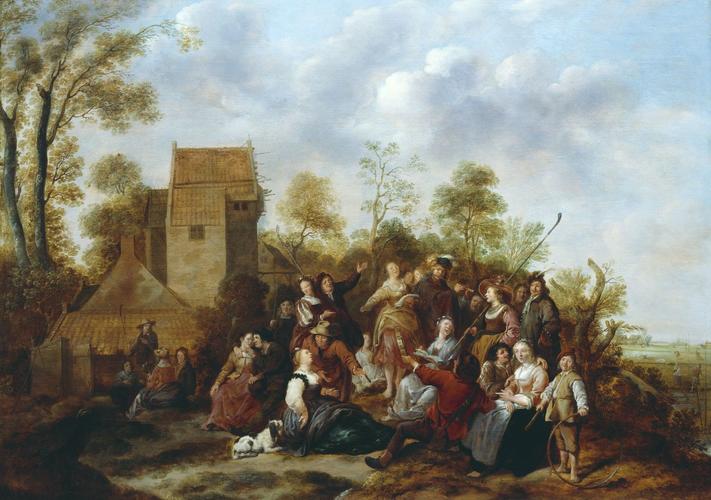-
1 of 253523 objects
Peasants Merrymaking out of Doors 1650-59
Oil on panel | 75.4 x 106.2 cm (support, canvas/panel/stretcher external) | RCIN 405490
-
Molenaer worked in and around his native Haarlem, except for a decade (1637 to 1648) spent in nearby Amsterdam. He belongs to a group of Haarlem painters who could loosely be termed followers of Frans Hals. The group included Dirck Hals, Willem Buytewech and Judith Leyster, whom Molenaer married in 1636. All these artists excelled in a form of extrovert and comic genre painting, depicting merry gatherings in low and high life. Though never life-size like Frans Hals’s, many of Molenaer’s figures are of a larger scale than those of most genre painters; they are carefully drawn and finished with a painterly flicker.
This scene of outdoor merriment by Jan Molenaer (c.1610-68) takes place near a group of impressive farm buildings, with dovecote and tiled roofs. In the right background are fertile polders (or reclaimed fields) with windmills maintaining constant drainage and a bleaching field, of the type shown near Haarlem in the paintings of Jacob van Ruisdael.
The figures in this scene are more difficult to characterise: they would seem to be imaginary, but are they real peasants or city-dwellers in fancy dress? The fashion for bucolic make-believe arises in part from the Arcadian poetry of the time and can be seen in many Dutch portraits, including Honthorst’s group of the children of the King and Queen of Bohemia as followers of Diana painted in 1631 (CW 77, 404971). Fashionable women dressed as shepherdesses with crooks and wide-brimmed hats were common: an example by Paulus Moreelse of 1633 is in the Museum of Fine Arts, Boston (see also CW 119, 404674). The woman seen in profile on the right of Molenaer’s group wears exactly such a hat and leans an houlette over her shoulder; the slashed sleeves, feathered caps and unused shepherd’s houlettes of the other merrymakers also read like stage properties. The group is engaged in courtship and in singing a rustic song to the accompaniment of pipes and a tambourine, both activities undertaken with the awkward decorousness of genteel folk trying to loosen up. As in many of Molenaer’s comic scenes there is the figure of a Chorus commenting upon the action, in this case the boy with the hoop on the right, sharing with us the joke that his elders and betters are as childish as he is in their pursuit of pleasure.
Signed lower centre: 'Jmolenaer'Provenance
First recorded in the Royal Collection during the reign of Queen Victoria
-
Creator(s)
(nationality) -
Medium and techniques
Oil on panel
Measurements
75.4 x 106.2 cm (support, canvas/panel/stretcher external)
Other number(s)
Alternative title(s)
A Dutch Merymaking
